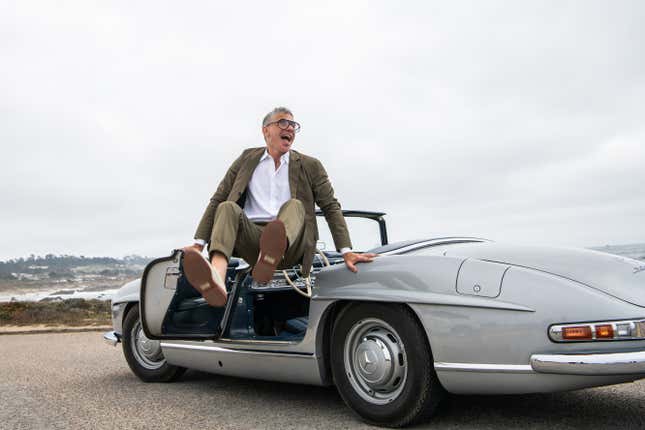Everyone has their own interpretation of luxury. To some, it means being pampered, suffused in buttery softness, like dwelling in a giant, fur-lined cashmere croissant. To others, it signifies exclusivity, a locking of the door behind them, like having Harry Styles play at your bar mitzvah.
For me, luxury is about timelessness, and in a car, that means a design that maintains its elegance, its comfort, and its status for long enough that I can comfortably age into driving it while wearing a captain’s hat and an ascot.
I am rapidly approaching that life stage — okay, I’m there — and after spending time boulevarding along Highway 1 in Big Sur behind the thin-rimmed, gigantic wheel of a low-mileage 1968 Mercedes 280 SL “Pagoda,” I’ve decided to relinquish the bohemian life of the writer and think up a profitable scam so that I can buy one.

The Pagoda is weird in the pantheon of SLs. It was the second born, sort of, following the progenitor, the hardcore sports cars that were the 300 SL Gullwing and Roadster. But it also internalized the DNA of that car’s stepbrother, the 190 SL, which was kind of a cushier factory-produced 300 SL knockoff, like the way Costco rebadges Courvoisier as Kirkland Cognac. But in truth, every SL is weird. That’s one of the greatest charms of the nameplate; it’s not stuck in memorializing the style or purpose of some eternal past, like the Porsche 911. It adapts to the times.
The times, in the early ‘60s, meant an expanding market for Mercedes-Benz cars, especially flagship sports cars. That meant a shift in focus: less Le Mans, more Le Corbusier. The result was vehicular high Modernism, where the luxury convertible was as much a clean, quiet conveyance — a machine for driving — as it was a symbol of refined good taste. (Remember, the arrival of the Pagoda coincided with Mercedes quitting racing entirely following some horrific competition crashes. The automaker avoided motorsports until the late 1980s.)

The Gullwing was an outlier beamed in from another galaxy; the Pagoda is not. Instead, it’s meant for spirited sporty driving — a weekend trip to the country, an elegant evening at the bistro. My jaunt up the Pacific Coast Highway during Monterey Car Week was the ideal venue.
The Pagoda is not exactly fast. Its 2.8-liter straight-six produces 168 hp, but more importantly, 180 lb-ft of torque, giving it a spirited sense, even when paired with the four-speed automatic transmission found in most US-market W113s. That transmission, or at least the one in this Mercedes-Benz Classic Center-owned example, mates well with the character of the car. It’s miraculously smooth. It reminded me of the gearbox in a Rolls-Royce, so unobtrusive and smooth that it felt like a cartoon butler, always there for me before I imagined the need. And I wasn’t trying to set any gymkhana records, or acquire any additional speeding tickets (particularly after the $625 penalty I got for a previous indiscretion on Highway 1 earlier in the week.)

Still, the supple steering from the thin-rimmed wheel was something of a revelation. The Pagoda steers as if engineers removed everything excessive from an S-Class and left in all of the over-engineering. It turns out a stiff structure, backed up with quality parts screwed together with lavish attention to detail, results in an excellent driving experience. It was like a C3 Corvette convertible that had been built competently, out of real materials, somewhere where laborers were treated with respect. So, nothing like an actual C3 Corvette.
Speaking of materials, I would be remiss if I didn’t mention the sensual delight and purity of everything that comes to hand in a Pagoda. Though the direct lineage to the Gullwing’s purposeful straightforwardness is evident in the painted metal, barely-padded dash, there’s a simplicity and honesty to the layout. Moreover, the textured steel trim around the sliders controlling the heater, the wooden trim around the defroster vents and windshield base, the all-metal heat vents — which we needed in the freezing northern California evening — reflected a quality you’d expect on today’s coachbuilt Bentleys and nothing less.
This is one of the profound joys of a Space-Age Mercedes. The cars are so excessively good at what they set out to do — in this case, providing an ideally comfortable roadster that looks and feels elegant literally everywhere — that they can’t help but induce delight in the human limbic system. One need only take a look at my face in these photos to recognize the outcome.

